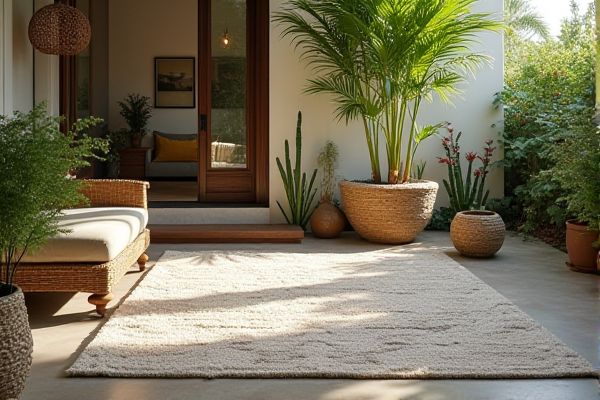
Outdoor rugs are designed with durable, weather-resistant materials to withstand sun, rain, and dirt, making them ideal for patios and decks, whereas indoor-outdoor carpets offer a versatile, cushioned option suitable for high-traffic areas both inside and outside your home. Explore the key differences in durability, comfort, and maintenance to choose the perfect floor covering for your space.
Table of Comparison
| Feature | Outdoor Rug | Indoor-Outdoor Carpet |
|---|---|---|
| Material | Polypropylene, Olefin, Synthetic fibers | Durable synthetic fibers, UV-resistant, water-repellent |
| Durability | Weather-resistant, fades slowly in sun | Highly durable, designed for heavy foot traffic |
| Water Resistance | Quick-drying, resists mold and mildew | Waterproof or water-resistant, inhibits mold growth |
| Maintenance | Easy to clean, hose or spot clean | Low maintenance, vacuum or hose down |
| Design | Variety of patterns, colors fit outdoor aesthetics | Often neutral or subtle designs for indoor/outdoor spaces |
| Comfort | Moderate cushioning, firm underfoot | Softer texture, suitable for prolonged indoor use |
| Installation | Loose lay, portable | Can be glued down or loose lay |
| Cost | Affordable to mid-range | Mid-range to premium |
What Is an Outdoor Rug?
An outdoor rug is specifically designed to withstand weather elements such as rain, sun, and dirt, using durable materials like polypropylene and synthetic fibers that resist mold and fading. Unlike indoor-outdoor carpets, outdoor rugs typically feature a non-slip backing and are easy to clean, making them ideal for patios, decks, and other exterior living spaces. Your choice of an outdoor rug ensures long-lasting style and functionality tailored to outdoor environments.
Defining Indoor-Outdoor Carpet
Indoor-outdoor carpet is a versatile flooring option designed to withstand both interior and exterior environments, featuring durable materials like polypropylene that resist moisture, mildew, and UV damage. Unlike traditional outdoor rugs, indoor-outdoor carpets often come in larger rolls suitable for extensive coverage and can be installed wall-to-wall, offering enhanced longevity and easy maintenance. These carpets combine aesthetic appeal with functionality, making them ideal for patios, sunrooms, and transitional spaces where durability and weather resistance are essential.
Material Differences
Outdoor rugs are typically made from durable, weather-resistant materials like polypropylene, which resist mold, mildew, and fading caused by sun exposure. Indoor-outdoor carpets also use synthetic fibers but often incorporate a denser weave and backing designed for both indoor comfort and outdoor durability. Your choice depends on whether you prioritize moisture resistance and UV protection or a softer feel suitable for indoor spaces with occasional outdoor use.
Durability and Longevity
Outdoor rugs typically offer superior durability and longevity due to their resistance to weather elements, UV rays, and moisture, making them ideal for patios and decks. Indoor-outdoor carpets combine the aesthetic appeal of indoor rugs with enhanced durability, often using synthetic fibers like polypropylene to withstand heavy foot traffic and resist stains. Your choice should factor in exposure to harsh conditions and desired lifespan, with outdoor rugs generally outperforming in extreme environments.
Installation and Placement
Outdoor rugs offer flexible installation options as they can be easily rolled out or swapped frequently on patios, decks, and balconies without adhesives or nails. Indoor-outdoor carpets require more secure placement techniques like double-sided tape or gluing to prevent shifting, especially in high-traffic or uneven areas. Proper installation ensures durability and safety, with outdoor rugs ideal for temporary setups and indoor-outdoor carpets suited for semi-permanent placements.
Maintenance and Cleaning
Outdoor rugs generally require less maintenance as they are designed to withstand exposure to the elements and can be easily shaken out or hosed down to remove dirt and debris. Indoor-outdoor carpets, while also durable, often need more thorough cleaning such as vacuuming and occasional deep cleaning to prevent mold and mildew buildup in more enclosed or semi-covered spaces. Both types benefit from prompt staining treatment and regular drying to maintain longevity and appearance.
Design and Style Options
Outdoor rugs offer a wide variety of vibrant patterns and textures designed to withstand weather elements, making them ideal for patios and decks. Indoor-outdoor carpets provide more durable materials with subtle, versatile designs suitable for both indoor living areas and outdoor spaces. Choosing the right style enhances your space's aesthetic while ensuring long-lasting performance tailored to your specific needs.
Comfort Underfoot
Outdoor rugs typically offer greater comfort underfoot due to their softer fibers and cushioned backing, making them ideal for patios and decks where you spend extended time barefoot. Indoor-outdoor carpets are designed for durability and moisture resistance, often featuring a denser weave that can feel firmer and less plush underfoot. Your choice should balance the need for comfort with durability depending on the intended use and location.
Cost Comparison
Outdoor rugs generally offer a more affordable option compared to indoor-outdoor carpets, with prices ranging from $20 to $150 depending on size and material quality. Indoor-outdoor carpets, often made with durable synthetic fibers like polypropylene, tend to be priced higher, typically between $100 and $300 per roll or large area rug. The cost difference is influenced by durability features such as weather resistance, UV protection, and ease of maintenance, which are more robust in indoor-outdoor carpets.
Best Uses for Each Option
Outdoor rugs excel in settings requiring portability and seasonal flexibility, such as patios, decks, and porches, where temporary coverage and easy cleaning are essential. Indoor-outdoor carpets are designed for more permanent installations in areas prone to moisture and heavy foot traffic, like sunrooms, entryways, and covered outdoor rooms, offering durability and resistance to mildew. Choosing between the two depends on the need for ease of maintenance versus long-term wear resistance in specific outdoor or semi-outdoor environments.
 homyna.com
homyna.com